Integration of Renewable Energy Sources into Low-Temperature District Heating Systems: A Review
Abstract
:1. Introduction
2. Configuration of a District Heating System
2.1. Heat Source
2.2. District Heating Network
2.3. End-Users
3. Renewable Energy Sources
- Integrating renewable energy based on ST collectors;
- Solar PV panels interacting with an electric HP-based space heating and cooling system;
- Solar thermal aided electric HP;
- Use of energy conversion systems with high efficiency (condensing boiler, cogeneration system, GSHP).
3.1. Solar Energy
3.1.1. Solar Thermal Systems
3.1.2. Solar Photovoltaic Systems
3.2. Geothermal Energy
3.2.1. Direct Use of Geothermal Energy to Provide Heat to Consumers
3.2.2. Heat Pump Systems
- Air or a gas (exterior air, warm air, or hot gases);
- Surface water, groundwater, geothermal, or hot waste water;
- The ground, which has the advantage of being easily accessible.
- Energy efficiency. The implementation of an HP in a heating/cooling system depends on energy indices and economic analyses. In heating mode, the operating an HP is characterised by the coefficient of performance (COP), which is defined as the ratio of useable thermal energy Et to electricity consumption Eel:
- Calculation of CO2 emissions. HPs powered by electrical energy derived from hydropower or renewable energy decrease GHG emissions, such as CO2, much more than HPs powered by electricity derived from coal, oil, or natural gas power plants.
- Heat pump types. The most prevalent method of HP categorisation is based on the heat source. There are two primary kinds of HPs: air-source HP (ASHP) and ground-source HP (GSHP), which includes water-source HP (WSHP) and ground-coupled HP (GCHP) systems.
3.2.3. A Brief Overview of Previous Works
3.3. Hydraulic Energy
4. Interconnection between DH System and Power Grid
5. Examples of Integrating RES in a DHS
5.1. Integration of WSHP Systems in Cooperation with ST and PV Collectors and Reduction in Supply Temperature in a DHS of 3rd Generation Adapted to 4th Generation Case Study 1
5.1.1. Description of the Systems
5.1.2. Simulation Results Utilising Polysun Software
5.2. Installation of the Micro Hydro-Turbines in a 3GDH System Case Study 2
6. Improving Energy Efficiency of Water Pumping in Heating Stations
6.1. A Brief Review of Previous Works
6.2. Evaluation of Energy Savings via Variable-Speed Drives Case Study 3
7. Conclusions
- The significant reason to use a DHS is its environmental benefit, and the fundamental advantage of RES is that it can be utilised with traditional fuels to build hybrid systems with higher performance (high energy efficiency, low CO2 emissions);
- Although low-temperature DHS would allow more low-grade heat to enter the supply, decentralised HPs are needed to raise the temperature before it enters the buildings;
- Most HPs installed in regions with warmer climates are air-source, while most HPs placed in regions with colder climates are ground-source. GSHPs have a COP between 3 and 5.5. They may retain high efficiency even at medium water temperatures in the radiator, making them an excellent option for modernising buildings without replacing the old heating terminal units. The SAGSHP hybrid system is comprised of two promising technologies that may be included in DHSs to reduce CO2 emissions;
- Geothermal and DH technologies need more research to cut prices and boost market competitiveness. The best ratio between building rehabilitation procedures and the incorporation of geothermal energy into a multi-depth system must be investigated;
- By integrating SAWSHP systems and reducing the supply temperature from 110 °C to 30 °C in DHS, which supplies the radiators to consumers in a district of Timisoara city in a 58/40 °C temperature regime and produces DHW at 52 °C, a thermal energy savings of 75%, a reduction in heat losses on the transmission network of 90%, and a reduction in CO2 emissions of 77% were achieved. Additionally, installed PV panels provide 1160 MWh/year of electricity utilised to balance the energy requirement of HP systems. Thus, the system’s energy efficiency (SPFsys) was enhanced by 2.30. For a second case study of the city of Timisoara, it was shown that excess energy from the DH network could be recovered using micro hydro-turbines (PATs) to produce 491 MW of electricity at an overall efficiency of 60%;
- The ability to use power produced from surplus hydraulic energy in the network on-site (e.g., by HX pumps or HPs) decreases the electrical energy consumption of network nodes with DH substations;
- Discharge regulation using VSPs is an attractive way of pumping water in DH plants, as it ensures a correlation between heat demand and water flow, resulting in up to 35% energy savings. Additionally, the excessive pressure levels that might result in equipment operating problems are prevented;
- In the future decades, new systems should be constructed using 5GDHC technology, and current systems should be rehabilitated or upgraded through new technologies towards environmentally sustainable hybrid systems with improved performance. Due to the bidirectional energy flows, a challenging task is modelling the optimal control of 5GDHC. Advanced controllers must account for uncertainties such as meteorological conditions, renewable energy production, and flexible consumer behaviour in DHS. Additionally, investment in research, development, and innovation in the DH field is essential to increase RES integration efficiency.
Author Contributions
Funding
Conflicts of Interest
References
- Anisimova, N. The capability to reduce primary energy demand in EU housing. Energy Build. 2011, 43, 2747–2751. [Google Scholar] [CrossRef]
- IEA. Energy Technology Perspectives 2016; International Energy Agency: Paris, France, 2016.
- Allard, F.; Seppänen, O. European actions to improve energy efficiency of buildings. REHVA J. 2008, 45, 10–20. [Google Scholar]
- EP. Directive 2010/31/EU on the Energy Performance of Buildings; European Parliament: Strasbourg, France, 2010.
- Sarbu, I.; Marza, M.; Crasmareanu, E. A review of modelling and optimisation techniques for district heating systems. Int. J. Energy Res. 2019, 43, 6572–6598. [Google Scholar] [CrossRef]
- European Association of District Heating and Cooling “Euroheat and Power”. District Heating and Cooling—Country by Country 2015 Survey; European Association of District Heating and Cooling: Brussels, Belgium, 2015. [Google Scholar]
- MRDPA; ME. Report on the Assessment of the National Potential to Implement High-Efficiency Cogeneration and Efficient District Heating And Cooling; Ministry of Regional Development and Public Administration; Ministry of Energy: Bucharest, Romania, 2015.
- Vallios, I.; Tsoutsos, T.; Papadakis, G. Design of biomass district heating systems. Biomass Bioenergy 2009, 33, 659–678. [Google Scholar] [CrossRef]
- Rezaie, B.; Rosen, M.A. District heating and cooling: Review of technology and potential enhancements. Appl. Energy 2012, 93, 2–10. [Google Scholar] [CrossRef]
- Hepbasli, A. A review on energetic, exergetic and exergoeconomic aspects of geothermal district heating systems (GDHSs). Energy Convers. Manag. 2010, 51, 2041–2061. [Google Scholar] [CrossRef]
- EC. Communication from the Commission to the European Parliament, the Council, the European Economic and Social Committee and the Committee of the Regions on an EU STRATEGY for Heating and Cooling; Technical Report; European Commission: Brussels, Belgium, 2016.
- ASHRAE Handbook. HVAC Systems and Equipment; American Society of Heating, Refrigerating and Air Conditioning Engineers: Atlanta, GA, USA, 2016. [Google Scholar]
- Frederiksen, S.; Werner, S. District Heating and Cooling; Studentlitteratur: Lund, Sweden, 2013. [Google Scholar]
- Lund, H.; Werner, S.; Wiltshire, R.; Svendsen, S.; Thorsen, J.E.; Hvelplund, F.; Mathiesen, B.V. 4th generation district heating (4GDH): Integrating smart thermal grids into future sustainable energy systems. Energy 2014, 68, 1–11. [Google Scholar] [CrossRef]
- Buffa, S.; Cozzini, M.; D’Antoni, M.; Baratieri, M.; Fedrizzi, R. 5th generation district heating and cooling systems: A review of existing cases in Europe. Renew. Sustain. Energy Rev. 2019, 104, 504–522. [Google Scholar] [CrossRef]
- Dalla Rosa, A.; Li, H.; Svendsen, S. Method for optimal design of pipes for low-energy district heating, with focus on heat losses. Energy 2011, 36, 2407–2418. [Google Scholar] [CrossRef]
- Srinivas, T.; Reddy, B.V. Comparative studies of augmentation in combined cycle power plants. Int. J. Energy Res. 2013, 38, 1201–1213. [Google Scholar] [CrossRef]
- Fang, H.; Xia, J.; Jiang, Y. Key issues and solutions in a district heating system using low-grade industrial waste heat. Energy 2015, 86, 589–602. [Google Scholar] [CrossRef]
- Chasapis, D.; Drosou, V.; Papamechael, I.; Aidonis, A.; Blanchard, R. Monitoring and operational results of a hybrid solar-biomass heating system. Renew. Energy 2008, 33, 1759–1767. [Google Scholar] [CrossRef]
- Mock, J.E.; Tester, J.W.; Wright, M.P. Geothermal energy from the Earth: Its potential impact as an environmentally sustainable resource. Annu. Rev. Energy Environ. 1997, 22, 305–356. [Google Scholar] [CrossRef]
- Cooper, S.J.G.; Hammond, G.P.; Norman, J.B. Potential for use of heat rejected from industry in district heating networks, GB perspective. J. Energy Inst. 2016, 89, 57–69. [Google Scholar] [CrossRef]
- Eriksson, M.; Vamling, L. Future use of heat pumps in Swedish district heating systems: Short- and long-term impact of policy instruments and planned investments. Appl. Energy 2007, 84, 1240–1257. [Google Scholar] [CrossRef]
- Ozgener, L. Coefficient of performance (COP) analysis of geothermal district heating systems (GDHSs): Salihli GDHS case study. Renew. Sustain. Energy Rev. 2012, 16, 1330–1334. [Google Scholar] [CrossRef]
- Werner, S. International review of district heating and cooling. Energy 2017, 137, 617–631. [Google Scholar] [CrossRef]
- Dalenbäck, J.O. Solar district heating and cooling. Euroheat Power 2013, 10, 26–29. [Google Scholar]
- Sarbu, I.; Sebarchievici, C. Solar Heating and Cooling Systems: Fundamentals, Experiments and Applications; Elsevier: Oxford, UK, 2017. [Google Scholar]
- Jie, P.; Tian, Z.; Yuan, S.; Zhu, N. Modeling the dynamic characteristics of a district heating network. Energy 2012, 39, 126–134. [Google Scholar] [CrossRef]
- Lund, R.; Mohammadi, S. Choice of insulation standard for pipe networks in 4th generation district heating systems. Appl. Therm. Eng. 2016, 98, 256–264. [Google Scholar] [CrossRef]
- Zvingilaite, E.; Ommen, T.; Elmegaard, B.; Franck, M.L. Low temperature DH consumer unit with micro heat pump for DHW preparation. In Proceedings of the 13th International Symposium on District Heating and Cooling, Copenhagen, Denmark, 3–4 September 2012. [Google Scholar]
- Østergaard, D.S.; Svendsen, S. Experience from a practical test of low-temperature district heating for space heating in five Danish single-family houses from the 1930s. Energy 2018, 159, 569–578. [Google Scholar] [CrossRef]
- Romanov, D.; Leiss, B. Geothermal energy at different depths for district heating and cooling of existing and future building stock. Renew. Sustain. Energy Rev. 2022, 167, 112727. [Google Scholar] [CrossRef]
- Sarbu, I. Advances in Building Services Engineering: Studies, Researches and Applications; Springer: Cham, Switzerland, 2021. [Google Scholar]
- ASHRAE Handbook. Fundamentals; American Society of Heating, Refrigerating and Air-Conditioning Engineers: Atlanta, GA, USA, 2021. [Google Scholar]
- Zirngib, J. Standardization activities for heat pumps. REHVA J. 2009, 46, 24–29. [Google Scholar]
- Crawley, D.B.; Lawrie, L.K.; Winkelmann, F.C.; Buhl, W.F.; Huang, Y.J.; Pedersen, C.O. EnergyPlus: Creating a new-generation building energy simulation program. Energy Build. 2001, 33, 319–331. [Google Scholar] [CrossRef]
- Klein, S.A.; Beckman, W.A.; Mitchell, J.W.; Duffie, J.A.; Duffie, N.A.; Freeman, T.L.; Mitchell, J.C.; Braun, J.E.; Evans, B.L.; Kummer, J.P.; et al. A Transient System Simulation Program User Manual; TRNSYS 17; Solar Energy Laboratory, University of Wisconsin: Madison, WI, USA, 2012. [Google Scholar]
- Guadalfajara, M.; Lozano, M.A.; Serra, L.M. Comparison of simple methods for the design of central solar heating plants with seasonal storage. Energy Procedia 2014, 48, 1110–1117. [Google Scholar] [CrossRef]
- Hippert, H.S.; Pedreira, C.E.; Souza, R.C. Neural networks for short-term load forecasting: A review and evaluation. IEEE Trans. Power Syst. 2001, 16, 44–55. [Google Scholar] [CrossRef]
- Gadd, H.; Werner, S. Fault detection in district heating substations. Appl. Energy 2015, 157, 51–59. [Google Scholar] [CrossRef]
- Hasan, A.; Kurnitski, J.; Jokiranta, K. A combined low temperature water heating system consisting of radiators and floor heating. Energy Build. 2009, 41, 470–479. [Google Scholar] [CrossRef]
- Johansson, P.O. Buildings and District Heating. Ph.D. Thesis, Lund University, Lund, Sweden, 2011. [Google Scholar]
- Abugabbara, M. Modelling and Simulation of the Fifth-Generation District Heating and Cooling. Bachelor’s Thesis, Lund University, Lund, Sweden, 2021. [Google Scholar]
- Kofinger, M.; Basciotti, D.; Schmidt, R.R. Reduction of return temperatures in urban district heating systems by the implementation of energy-cascades. Energy Procedia 2017, 116, 438–451. [Google Scholar] [CrossRef]
- Wang, H.; Meng, H.; Long, W. A district energy planning method with mutual interconnection and interchange of thermal grids. Procedia Eng. 2017, 205, 1412–1419. [Google Scholar] [CrossRef]
- Zarin Pass, R.; Wetter, M.; Piette, M.A. A thermodynamic analysis of a novel bidirectional district heating and cooling network. Energy 2018, 144, 20–30. [Google Scholar] [CrossRef]
- Dunkelberg, E.; Schneller, A.; Bachmann, M.; Kriegel, M. LowExTra—Feasibility of a multi-conductor district heating system. Energy Procedia 2018, 149, 427–434. [Google Scholar] [CrossRef]
- Yan, A.; Zhao, J.; An, Q.; Zhao, Y.; Li, H.; Huang, Y.J. Hydraulic performance of a new district heating systems with distributed variable speed pumps. Appl. Energy 2013, 112, 876–885. [Google Scholar] [CrossRef]
- Muresan, A.; Attia, S. Energy efficiency in the Romanian residential building stock: A literature review. Renew. Sustain. Energy Rev. 2017, 74, 349–363. [Google Scholar] [CrossRef]
- ANRE. National Authority of Energy Settlement. 2012. Available online: http://www.anre.ro (accessed on 15 February 2014).
- Sarbu, I.; Adam, M. Applications of solar energy for domestic hot water and buildings heating/cooling. Int. J. Energy 2011, 5, 34–42. [Google Scholar]
- IEA. Solar Combisystems; IEA Task 26; International Energy Agency: Paris, France, 2002.
- Balaras, C.A.; Dascalaki, P.; Tsekouras, P.; Aidonis, A. High solar combisystems in Europe. ASRAE Trans. 2010, 116, 408–415. [Google Scholar]
- Weiss, W. Solar Heating Systems for Houses: A Design Handbook for Solar Combisystems; Cromwell Press: London, UK, 2003. [Google Scholar]
- Andersen, E.; Shah, I.J.; Furbo, S. Thermal performance of Danish solar combisystems in practice and in theory. J. Sol. Energy Eng. 2004, 126, 744–749. [Google Scholar] [CrossRef]
- Kacan, E.; Ulgen, K. Energy analysis of solar combisystems in Turkey. Energy Convers. Manag. 2012, 64, 378–386. [Google Scholar] [CrossRef]
- Assae, R.; Ugursal, I.; Morrison, I.; Nen-Abdallah, N. Preliminary study for solar combisystem potential in Canadian houses. Appl. Energy 2014, 130, 510–518. [Google Scholar] [CrossRef]
- Ellehauge, K.; Shah, I.J. Solar combisystems in Denmark—The most common system designs. In Proceedings of the EuroSun 2000—ISES Europe Solar Congress Proceedings, Copenhagen, Denmark, 19–22 June 2000. [Google Scholar]
- Kacan, E. Design, Application, Energy and Exergy Analysis of Solar Combisystems. Ph.D. Thesis, Ege University, Ege, Turkey, 2011. [Google Scholar]
- Hin, J.N.C.; Zmeureanu, R. Optimization of a residential solar combisystem for minimum life cycle cost, energy use and exergy destroyed. Sol. Energy 2014, 100, 102–113. [Google Scholar]
- Urban, P.; Sven, W. District heating in sequential energy supply. Appl. Energy 2012, 95, 123–131. [Google Scholar]
- Urban, P.; Sven, W. Heat distribution and the future competitiveness of district heating. Appl. Energy 2011, 88, 568–576. [Google Scholar]
- Schmidt, T.; Mangold, D. Large-Scale Thermal Energy Storage—Status Quo and Perspectives. In Proceedings of the First International Solar District Heating Conference, Malmö, Sweden, 3–4 June 2013. [Google Scholar]
- Solangi, K.H.; Islam, M.R.; Saidur, R.; Rahim, N.A.; Fayaz, H. A review on global solar energy policy. Renew. Sustain. Energy Rev. 2011, 15, 2149–2163. [Google Scholar] [CrossRef]
- Sarbu, I.; Sebarchievici, C. Review of solar refrigeration and cooling systems. Energy Buldings 2013, 67, 286–297. [Google Scholar] [CrossRef]
- Axaopoulos, P.J.; Fylladitakis, E.D. Performance and economic evaluation of a hybrid photovoltaic/ thermal solar system for residential applications. Energy Build. 2013, 65, 488–496. [Google Scholar] [CrossRef]
- Graell, G.G.; Xydis, G. Solar thermal in the Nordics. A belated boom for all or not? AIMS Energy 2022, 10, 69–86. [Google Scholar] [CrossRef]
- Holmberg, H.; Acuna, J.; Næss, E.; Sønju, O.K. Thermal evaluation of coaxial deep borehole heat exchangers. Renew. Energy 2016, 97, 65–76. [Google Scholar] [CrossRef]
- Moya, D.; Aldas, C.; Kaparaju, P. Geothermal energy: Power plant technology and direct heat applications. Renew. Sustain. Energy Rev. 2018, 94, 889–901. [Google Scholar] [CrossRef]
- Marasescu, D.; Mateiu, A. Utilizing the potential of low enthalpy geothermal resources for heat supply to localities. ISPE Bull. 2013, 57, 10–27. [Google Scholar]
- Gavriliuc, R.; Rosca, M.; Bendea, C.; Antal, C.; Cucueteanu, D. Geothermal energy in Romania—Country update 2015–2019. In Proceedings of the World Geothermal Congress 2020, Reykjavik, Iceland, 24–27 October 2020. [Google Scholar]
- Seppänen, O. European parliament adopted the directive on the use of renewable energy sources. REHVA J. 2009, 46, 12–14. [Google Scholar]
- Sarbu, I.; Sebarchievici, C. Ground-Source Heat Pumps: Fundamentals, Experiments and Applications; Elsevier: Oxford, UK, 2016. [Google Scholar]
- Zühlsdorf, B.; Jensen, J.K.; Elmegaard, B. Heat pump working fluid selection—economic and thermodynamic comparison of criteria and boundary conditions. Int. J. Refrig. 2019, 98, 500–513. [Google Scholar] [CrossRef]
- IEE. Intelligent Energy Europe. 2013. Available online: http://ec.europa.eu/energy/environment (accessed on 15 February 2014).
- ASHRAE Handbook. HVAC Applications; American Society of Heating, Refrigerating and Air–Conditioning Engineers: Atlanta, GA, USA, 2019. [Google Scholar]
- Pahud, D.; Mattthey, B. Comparison of the thermal performance of double U-pipe borehole heat exchanger measured in situ. Energy Build. 2001, 33, 503–507. [Google Scholar] [CrossRef]
- Bernier, M. Closed-loop ground-coupled heat pump systems. ASHRAE J. 2006, 48, 13–24. [Google Scholar]
- Luo, J.; Rohn, J.; Bayer, M.; Priess, A. Modeling and experiments on energy loss in horizontal connecting pipe of vertical ground source heat pump system. Appl. Therm. Eng. 2013, 60, 55–64. [Google Scholar] [CrossRef]
- Sarbu, I.; Sebarchievici, C. General review of ground-source heat pump system for heating and cooling of building. Energy Build. 2014, 70, 441–454. [Google Scholar] [CrossRef]
- Omer, A.M. Ground-source heat pumps systems and applications. Renew. Sustain. Energy Rev. 2008, 12, 344–371. [Google Scholar] [CrossRef]
- Reinsch, T.; Dobson, P.; Asanuma, H.; Huenges, E.; Poletto, F.; Sanjuan, B. Utilizing supercritical geothermal systems: A review of past ventures and ongoing research activities. Geotherm. Energy 2017, 5, 16. [Google Scholar] [CrossRef]
- Ezzat, M.; Vogler, D.; Saar, M.O.; Adams, B.M. Simulating Plasma formation in pores under short electric pulses for Plasma pulse Geo drilling (PPGD). Energies 2021, 14, 4717. [Google Scholar] [CrossRef]
- Leiss, B.; Wagner, B.; Heinrichs, T.; Romanov, D.; Tanner, D.; Vollbrecht, A.; Wemmer, K. Integrating deep, medium and shallow geothermal energy into district heating and cooling system as an energy transition approach for the Gottingen University Campus. In Proceedings of the World Geothermal Congress 2021, Reykjavik, Iceland, 24–27 October 2021; pp. 1–9. [Google Scholar]
- Blazquez, C.S.; Martín, A.F.; Nieto, I.M.; Gonzalez-Aguilera, D. Economic and environmental analysis of different district heating systems aided by geothermal energy. Energies 2018, 11, 1265. [Google Scholar] [CrossRef]
- Wang, Y.; He, W. Temporospatial techno-economic analysis of heat pumps for decarbonising heating in Great Britain. Energy Build. 2021, 250, 111198. [Google Scholar] [CrossRef]
- Zeng, H.; Diao, N.; Fang, Z. Heat transfer analysis of boreholes in vertical ground heat exchangers. Int. J. Heat Mass Transf. 2003, 46, 4467–4481. [Google Scholar] [CrossRef]
- Cui, Y.; Zhu, J.; Twaha, S.; Chu, J.; Bai, H.; Huang, K.; Chen, X.; Zoras, S.; Soleimani, Z. Techno-economic assessment of the horizontal geothermal heat pump systems: A comprehensive review. Energy Convers. Manag. 2019, 191, 208–236. [Google Scholar] [CrossRef]
- Congedo, P.M.; Colangelo, G.; Starace, G. CFD simulations of horizontal ground heat exchangers: A comparison among different configurations. Appl. Therm. Eng. 2012, 33–34, 24–32. [Google Scholar] [CrossRef]
- Pratiwi, A.S.; Trutnevyte, E. Life cycle assessment of shallow to medium-depth geothermal heating and cooling networks in the State of Geneva. Geothermics 2021, 90, 101988. [Google Scholar] [CrossRef]
- Wang, G.; Song, X.; Shi, Y.; Yulong, F.; Yang, R.; Li, J. Comparison of production characteristics of various coaxial closed-loop geothermal systems. Energy Convers. Manag. 2020, 225, 113437. [Google Scholar] [CrossRef]
- Nouri, G.; Noorollahi, Y.; Yousefi, H. Solar assisted ground source heat pump systems—A review. Appl. Therm. Eng. 2019, 163, 114351. [Google Scholar] [CrossRef]
- Bi, Y.; Guo, T.; Zhang, L.; Chen, L. Solar and ground source heat pump system. Appl. Energy 2004, 78, 231–245. [Google Scholar]
- Ozgener, O.; Hepbasli, A. Performance analysis of a solar assisted ground-source heat pump system for greenhouse heating: An experimental study. Build. Environ. 2005, 40, 1040–1050. [Google Scholar] [CrossRef]
- Han, Z.; Zheng, M.; Kong, F.; Wang, F.; Li, Z.; Bai, T. Numerical simulation of solar assisted ground-source heat pump heating system with latent heat energy storage in severely cold area. Appl. Therm. Eng. 2008, 28, 1427–1436. [Google Scholar]
- Guelpa, E.; Verda, V. Thermal energy storage in district heating and cooling systems: A review. Appl. Energy 2019, 252, 113474. [Google Scholar] [CrossRef]
- Gadd, H.; Werner, S. Thermal energy storage systems for district heating and cooling. In Advances in Thermal Energy Storage System: Methods and Applications; Elsevier: Amsterdam, The Netherlands, 2021; pp. 625–638. [Google Scholar]
- Su, P.A.; Karney, B. Micro hydroelectric energy recovery in municipal water system: A case study for Vancouver. Urban Water J. 2015, 12, 678–690. [Google Scholar] [CrossRef]
- Carravetta, A.; Fecarotta, O.; Ramos, H.M. A new low-cost installation scheme of PATs for pico-hydropower to recover energy in residential areas. Renew. Energy 2018, 125, 1003–1014. [Google Scholar] [CrossRef]
- Alberizzi, J.C.; Renzi, M.; Nigro, A.; Ross, M. Study of a pump-as-turbine (PAT) speed control for a water distribution network (WDN) in South-Tyrol subjected to high variable water flow rates. Energy Procedia 2018, 148, 226–233. [Google Scholar] [CrossRef]
- Morani, M.C.; Carravetta, A.; D’Ambrosio, C.; Fecarotta, O. A new mixed integer non-linear programming model for optimal PAT and PRV location in water distribution networks. Urban Water J. 2021, 18, 394–409. [Google Scholar] [CrossRef]
- Ramos, H.M.; Rui Silva Santos, R.S.; Lopez-Jimenez, P.A.; Perez-Sanchez, M. Multi-objective optimization tool for PATs operation in water pressurized systems. Urban Water J. 2022, 19, 558–568. [Google Scholar] [CrossRef]
- Borkowski, D.; Sułowicz, M.; Węgiel, T.; Liszka, D. Electrical energy recovery from network water pressure. In Proceedings of the 12th Conference on Selected Problems of Electrical Engineering and Electronics, Kielce, Poland, 17–19 September 2015; pp. 55–60. [Google Scholar]
- Borkowski, D.; Węgiel, T. Analysis of energy recovery from surplus water pressure of municipal heat distribution network. In Proceedings of the Earth and Environmental Science, 2nd International Conference on the Sustainable Energy and Environmental Development, Krakow, Poland, 14–17 November 2019; Volume 214. Article Number 012014. [Google Scholar]
- ESHA. Energy Recovery in Existing Infrastructures with Small Hydropower Plants; European Small Hydropower Association: Brussels, Belgium, 2010. [Google Scholar]
- Hosseini, S.M.; Carli, R.; Dotoli, M. Robust optimal energy management of a residential microgrid under uncertainties on demand and renewable power generation. IEEE Trans. Autom. Sci. Eng. 2021, 18, 618–637. [Google Scholar] [CrossRef]
- Sperstad, I.B.; Korpås, M. Energy storage scheduling in distribution systems considering wind and photovoltaic generation uncertainties. Energies 2019, 12, 1231. [Google Scholar] [CrossRef]
- Byrne, R.H.; Nguyen, T.A.; Copp, D.A.; Chalamala, B.R.; Gyuk, I. Energy management and optimization methods for grid energy storage systems. IEEE Access 2017, 6, 13231–13260. [Google Scholar] [CrossRef]
- Xu, J.; Wang, R.Z.; Li, Y. A review of available technologies for seasonal thermal energy storage. Sol. Energy 2014, 103, 610–638. [Google Scholar] [CrossRef]
- Abusoglu, A.; Kanoglu, M. Exergoeconomic analysis and optimization of combined heat and power production: A review. Renew. Sustain. Energy Rev. 2009, 13, 2295–2308. [Google Scholar] [CrossRef]
- Brand, M.; Svendsen, S. Renewable-based low-temperature district heating for existing buildings in various stages of refurbishment. Energy 2013, 62, 311–319. [Google Scholar] [CrossRef]
- Kim, M.; Parkt, S.; Choi, J.K.; Lee, J. Energy independence of energy trading system in microgrid. In Proceedings of the 2017 IEEE Innovative Smart Grid Technologies—Asia (ISGT-Asia), Auckland, New Zealand, 4–7 December 2017; pp. 1–4. [Google Scholar]
- Rosca, M.; Antics, M.; Sferle, M. Geothermal Energy in Romania: Country Update 2000–2004. In Proceedings of the World Geothermal Congress 2005, Antalya, Turkey, 24–29 April 2005; pp. 1–8. [Google Scholar]
- Colesca, S.E.; Ciocoiu, C.N. An overview of the Romanian renewable energy sector. Renew. Sustain. Energy Rev. 2013, 24, 149–158. [Google Scholar] [CrossRef]
- Tarragona, J.; Pisello, A.L.; Fernández, C.; Gracia, A.; Cabeza, L.F. Systematic review on model predictive control strategies applied to active thermal energy storage systems. Renew. Sustain. Energy Rev. 2021, 149, 111385. [Google Scholar] [CrossRef]
- Rawlings, J.; Mayne, D. Model Predictive Control Theory and Design; Nob Hill Publishing: Madison, WI, USA, 2009; 533p. [Google Scholar]
- Li, Q.; Zou, X.; Pu, Y.; Chen, W. A real-time energy management method for electric-hydrogen hybrid energy storage microgrid based on DP-MPC. CSEE J. Power Energy Syst. 2020, 1–13. [Google Scholar] [CrossRef]
- Thieblemont, H.; Haghighat, F.; Ooka, R.; Moreau, A. Predictive control strategies based onweather forecast in buildings with energy storage system: A review of the state-of-the art. Energy Build. 2017, 153, 485–500. [Google Scholar] [CrossRef]
- Carli, R.; Cavone, G.; Pippia, T.; De Schutter, B.; Dotoli, M. Robust Optimal Control for Demand Side Management of Multi-Carrier Microgrids. IEEE Trans. Autom. Sci. Eng. 2022, 19, 1338–1351. [Google Scholar] [CrossRef]
- Polysun Software. User Manual; Vela Solaris AG: Winterthur, Switzerland, 2020. [Google Scholar]
- Meteonorm. Help, Version 7.1; Meteonorm Software: Bern, Switzerland, 2015. [Google Scholar]
- Sarbu, I.; Borza, I. Energetic optimization of water pumping in distribution systems. Period. Polytech. Mech. Eng. 1998, 2, 141–152. [Google Scholar]
- Rishel, J.B. Water Pumps and Pumping Systems; McGraw-Hill: New York, NY, USA, 2002. [Google Scholar]
- Pérez-Sánchez, M.; López-Jiménez, P.A.; Ramos, H.M. Modified affinity laws in hydraulic machines towards the best efficiency line. Water Resour. Manag. 2018, 32, 829–844. [Google Scholar] [CrossRef]
- Hooper, W. Advantages of parallel pumping. Plant Eng. 1999, 31, 4–6. [Google Scholar]
- Volk, M. Pump Characteristics and Applications; Taylor & Francis: Boca Raton, FL, USA, 2005. [Google Scholar]
- Sarbu, I.; Valea, E.S. Energy savings potential for pumping water in district heating stations. Sustainability 2015, 7, 5705–5719. [Google Scholar] [CrossRef]
- Marchi, A.; Simpson, A.R.; Ertugrul, N. Assessing variable speed pump efficiency in water distribution systems. Drink. Water Eng. Sci. 2012, 5, 15–21. [Google Scholar] [CrossRef] [Green Version]
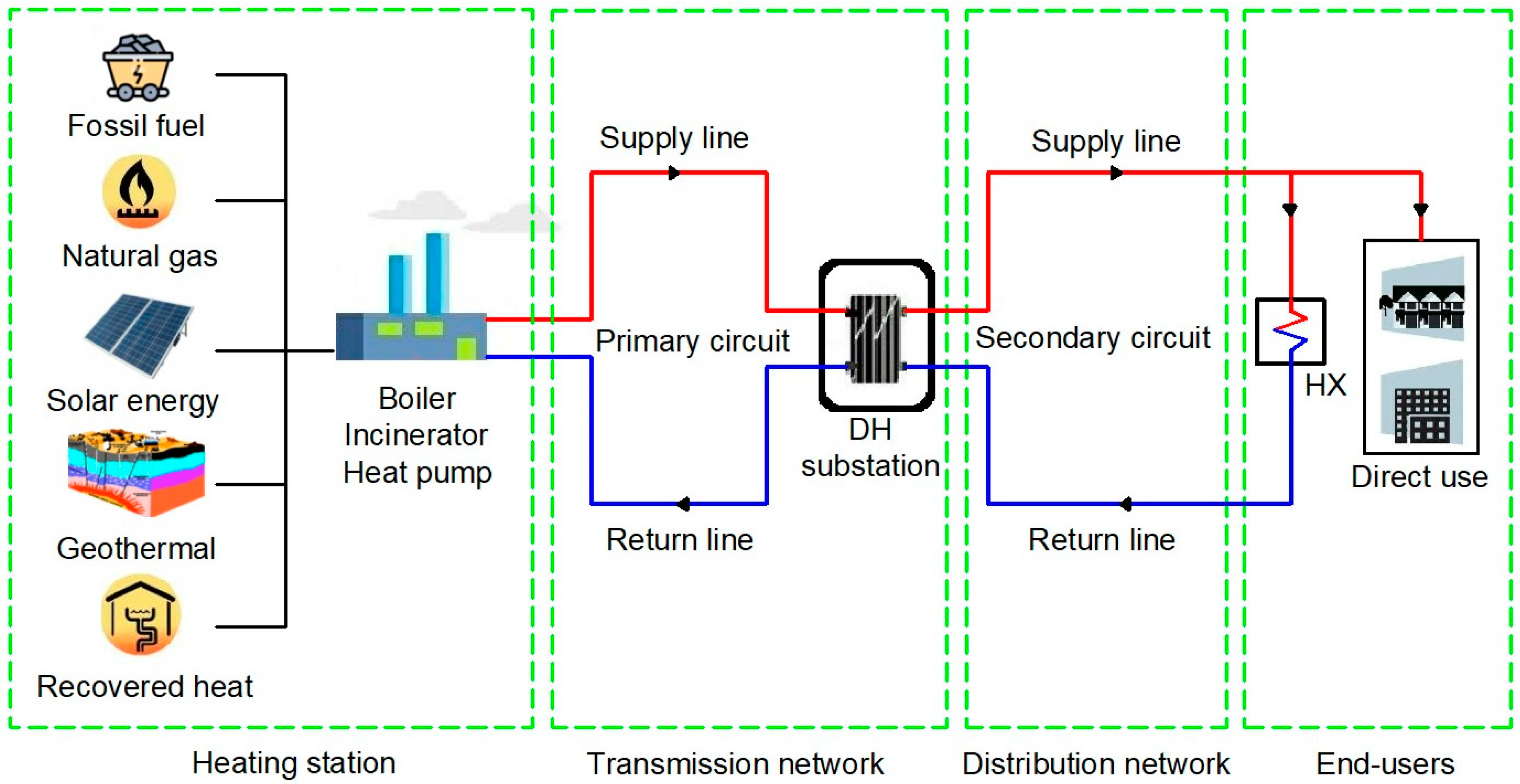

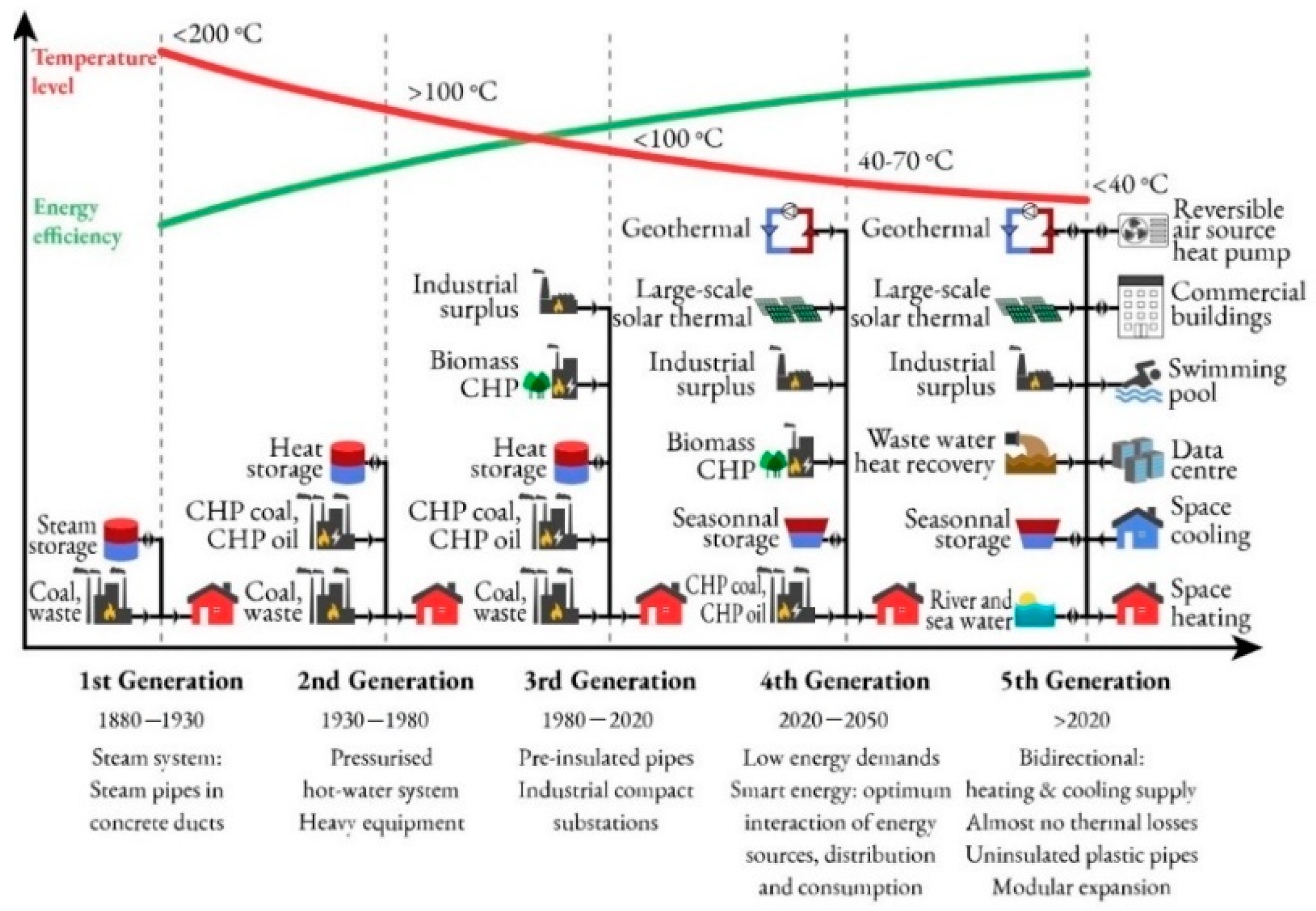
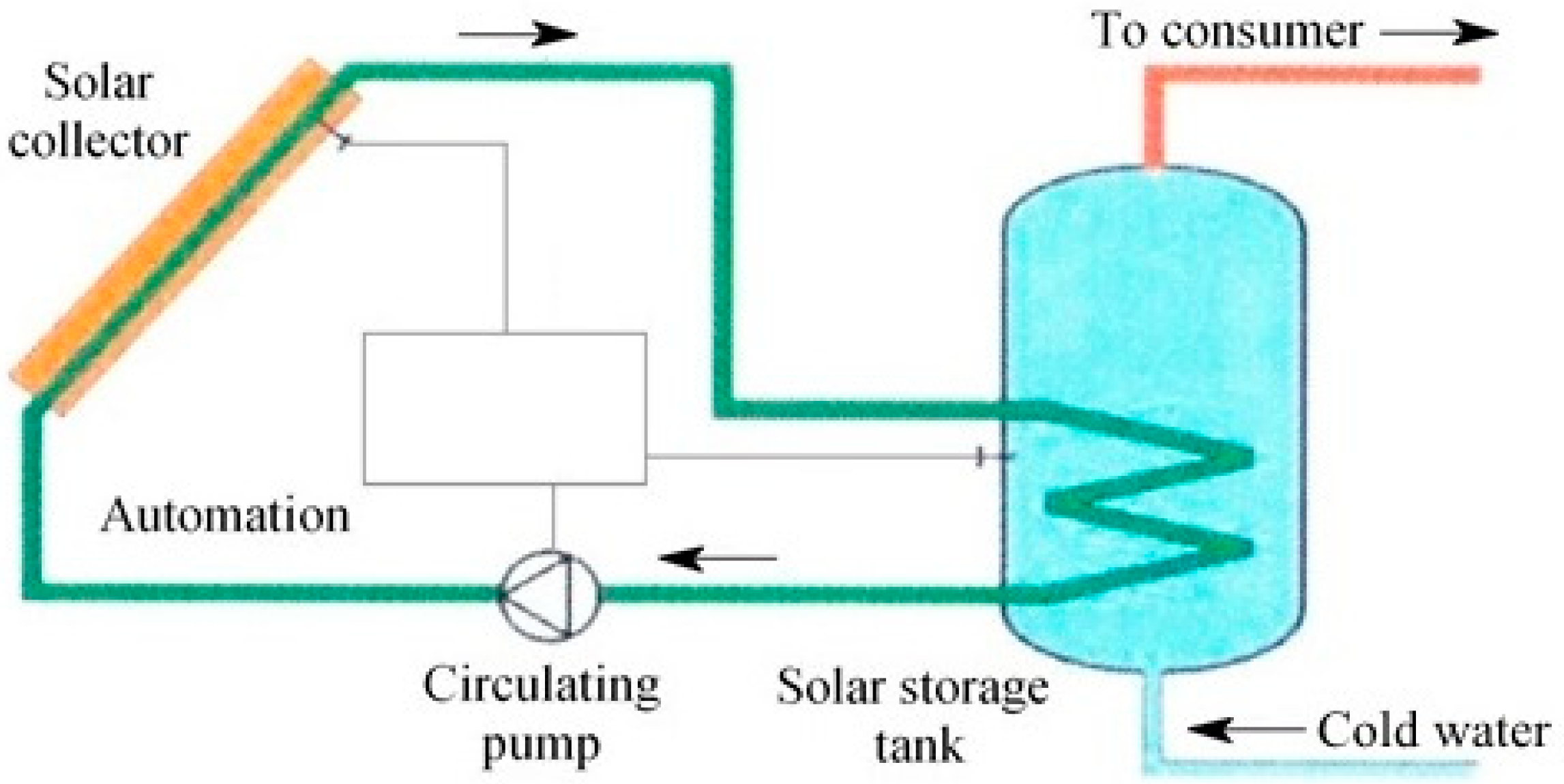

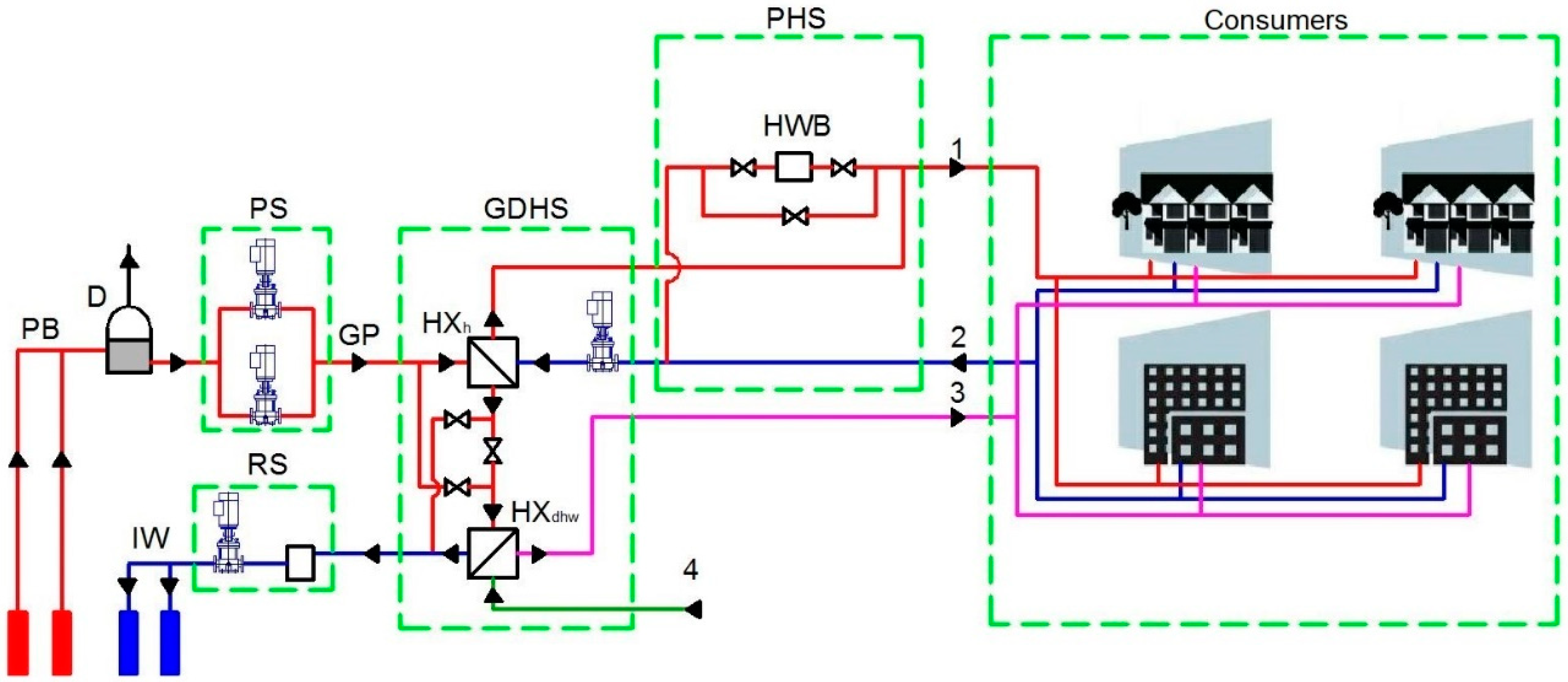
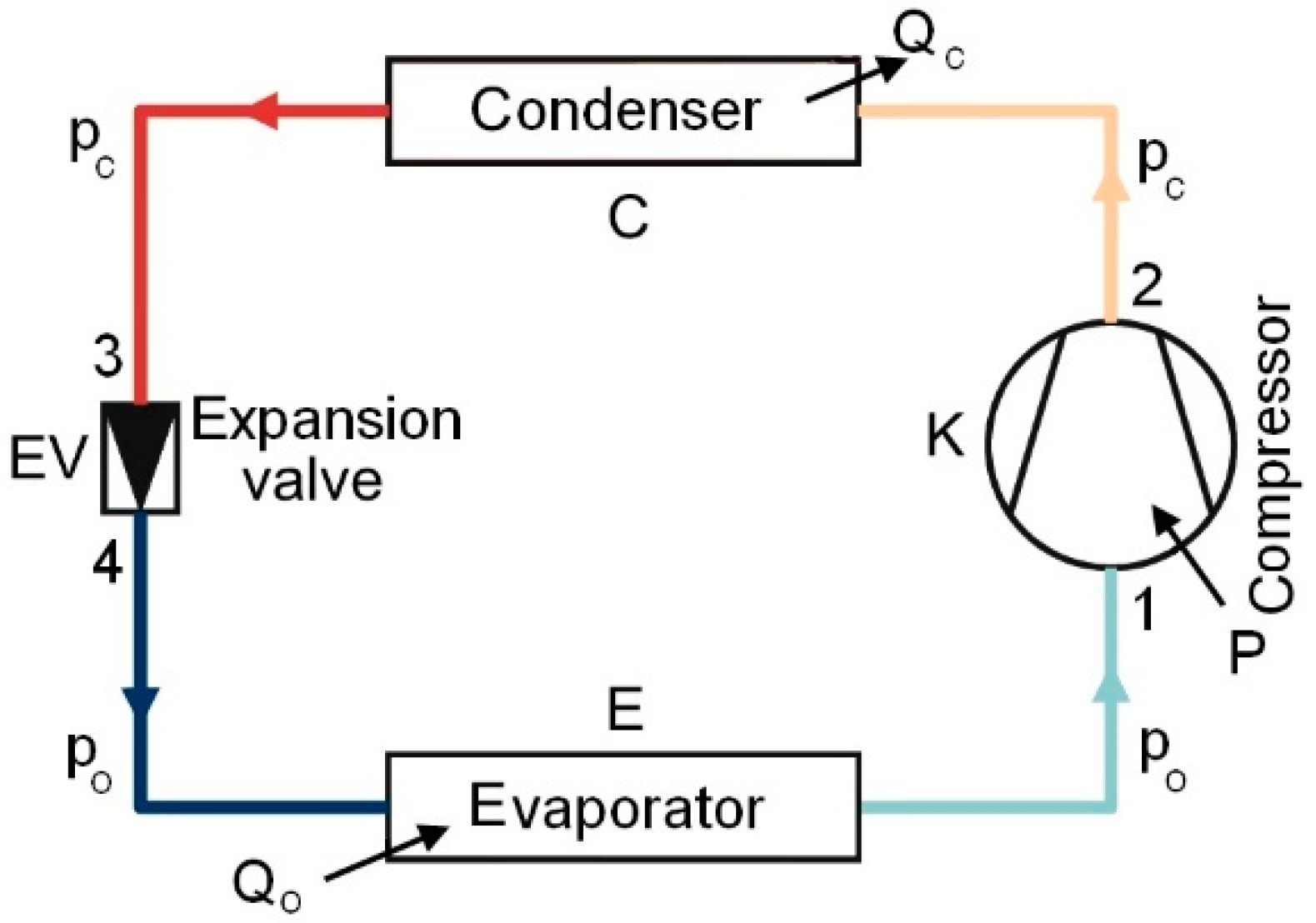
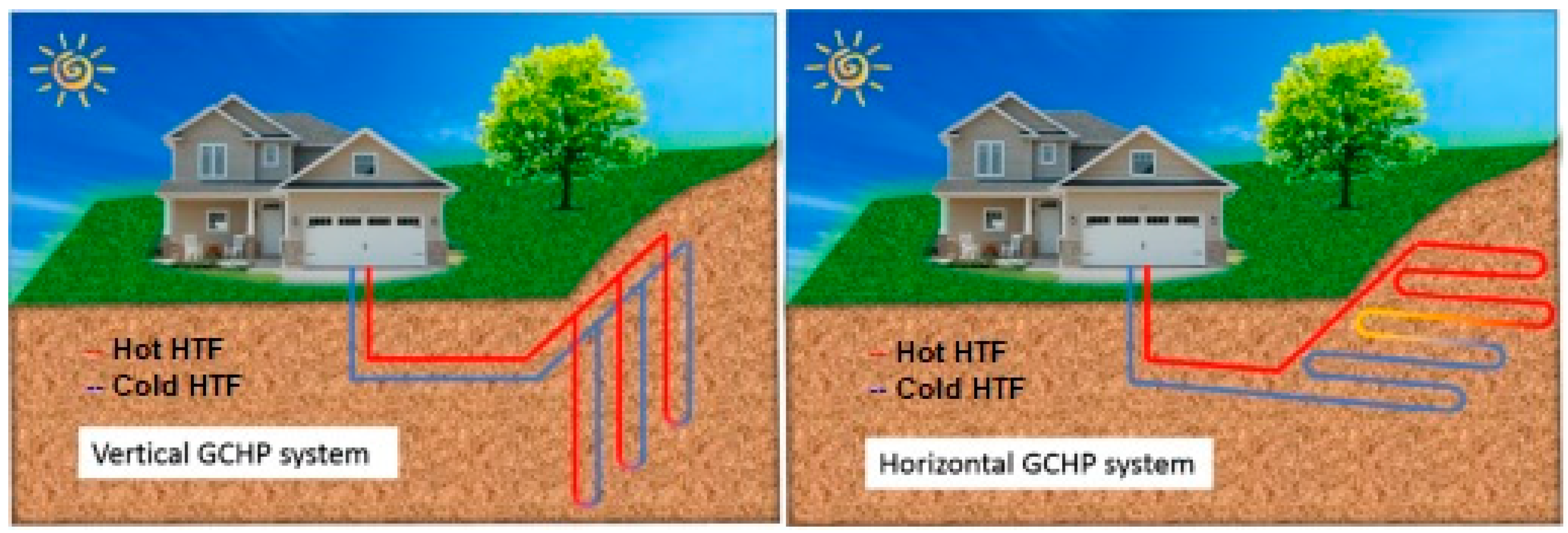

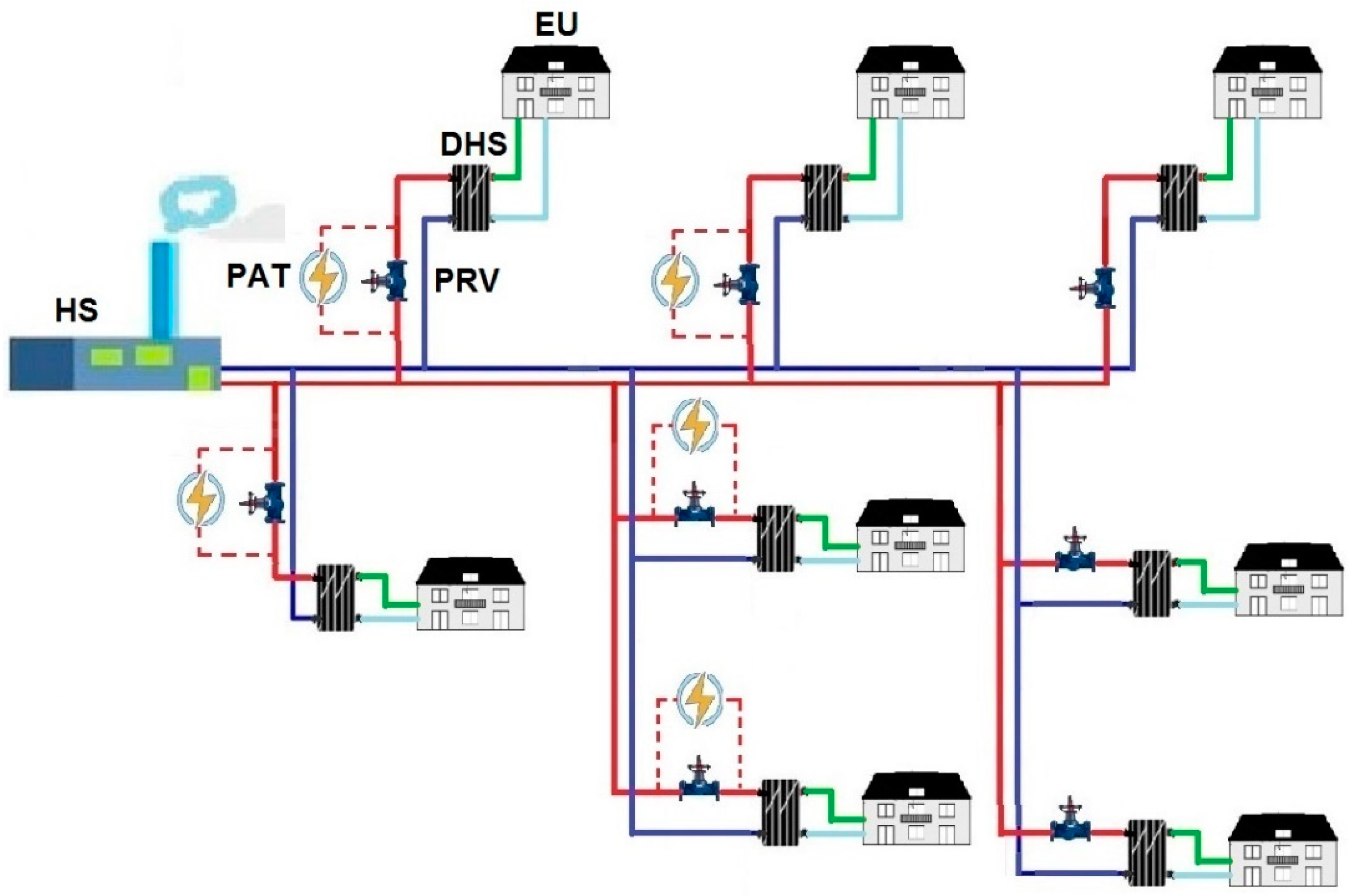
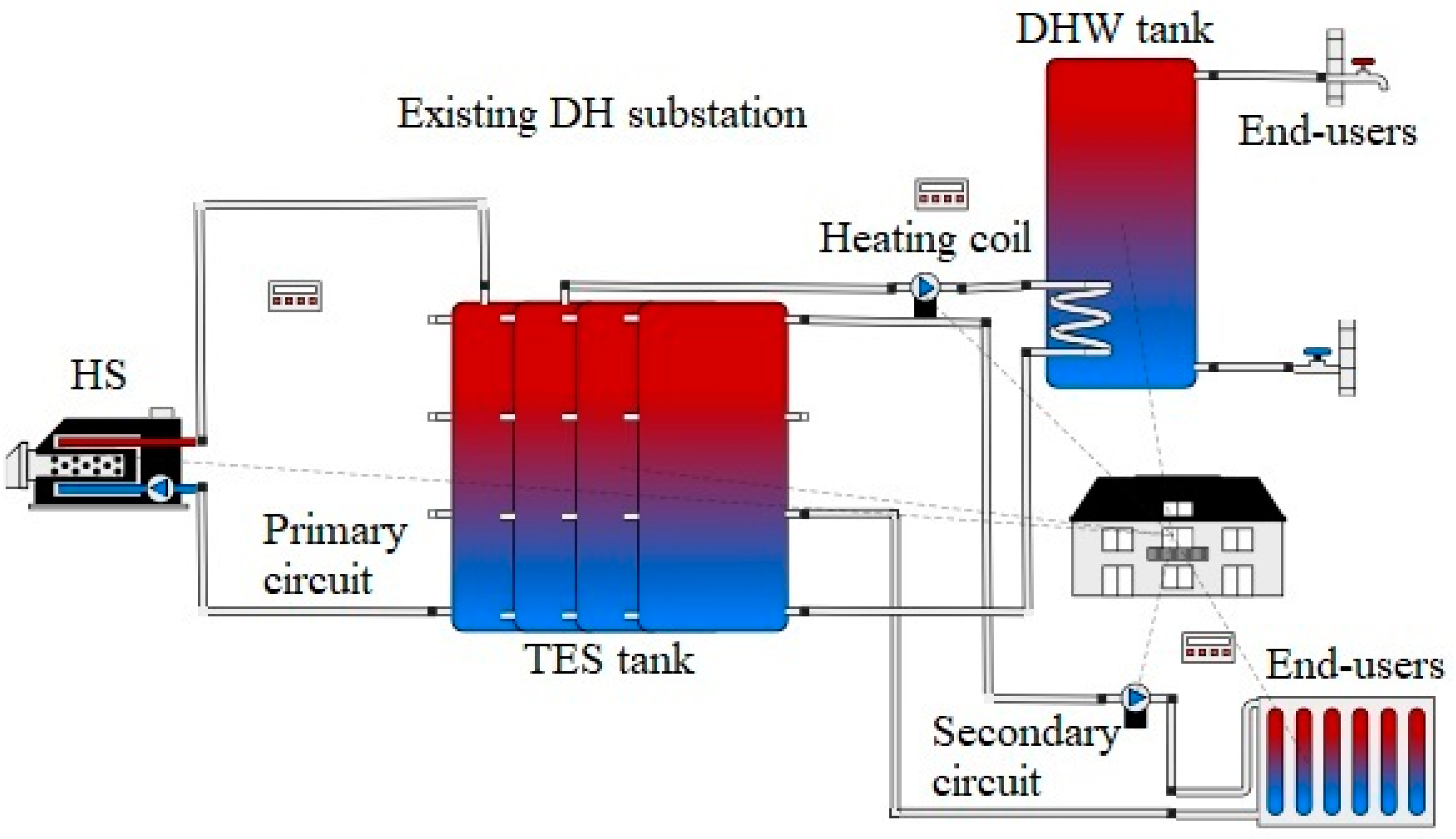
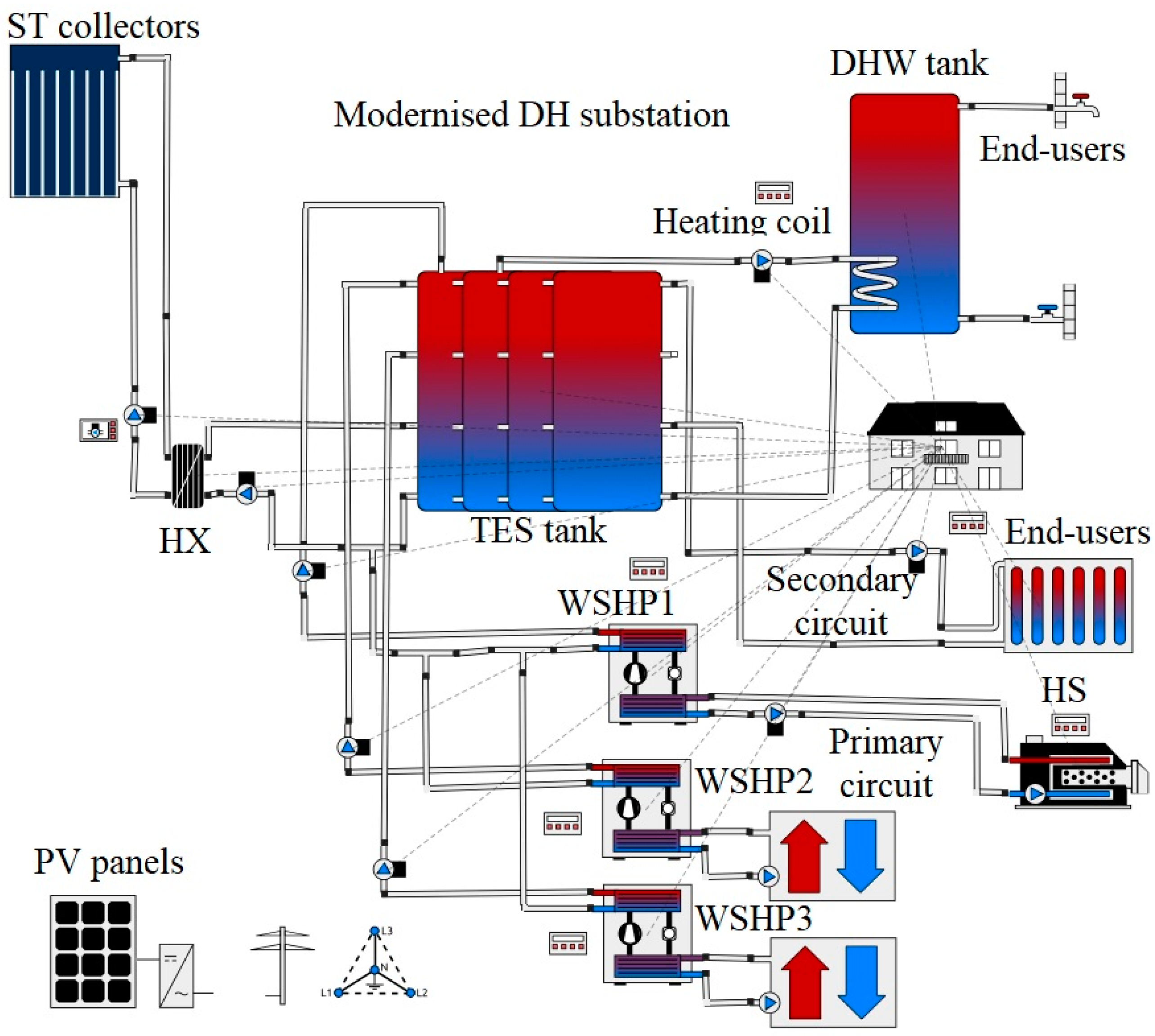
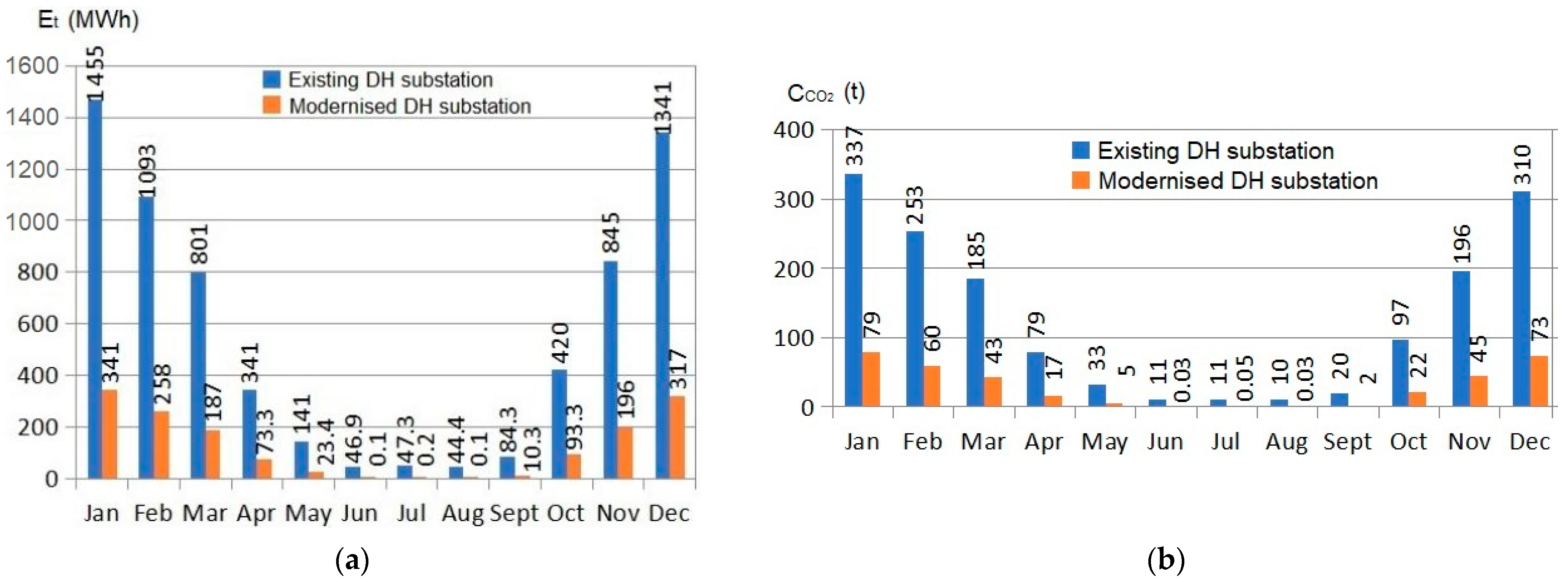

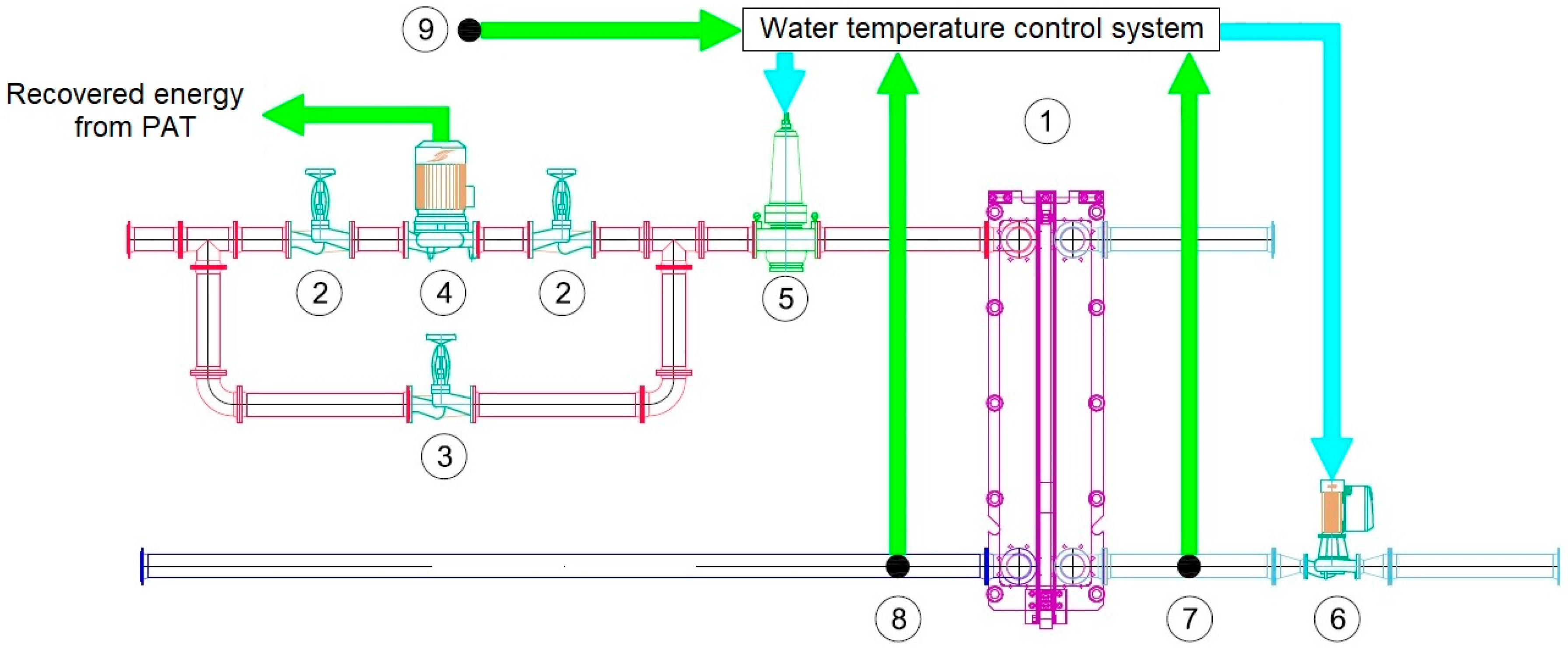
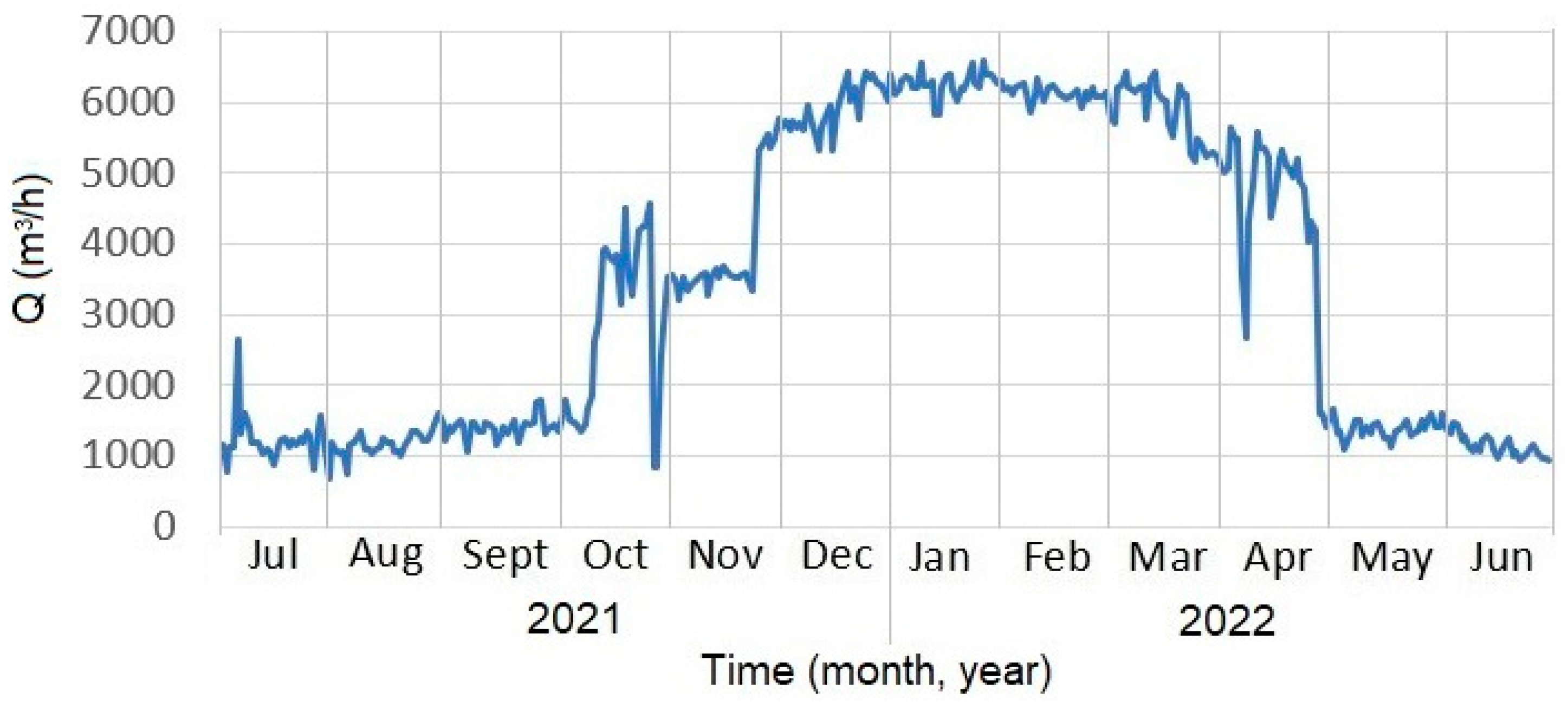
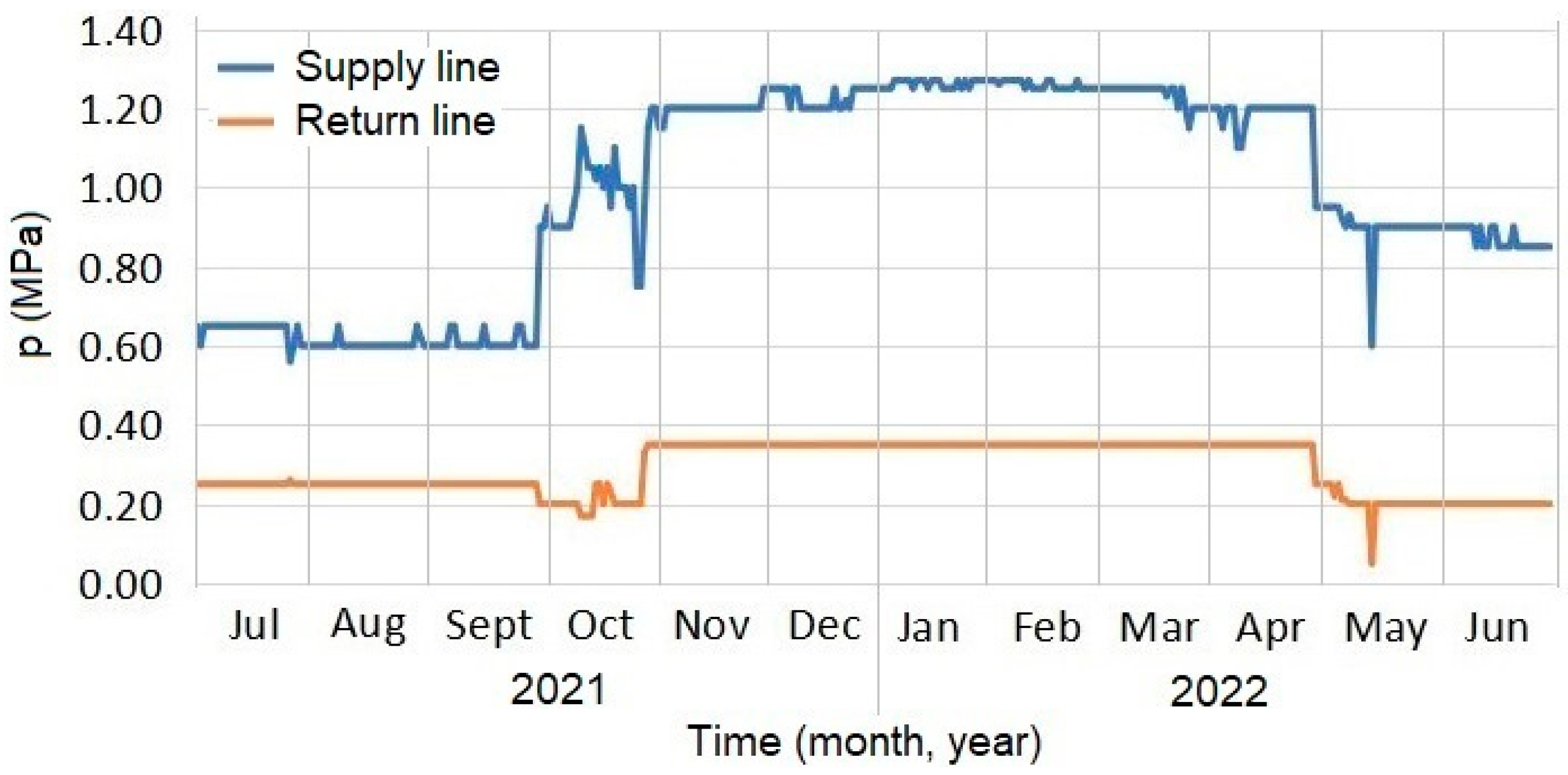
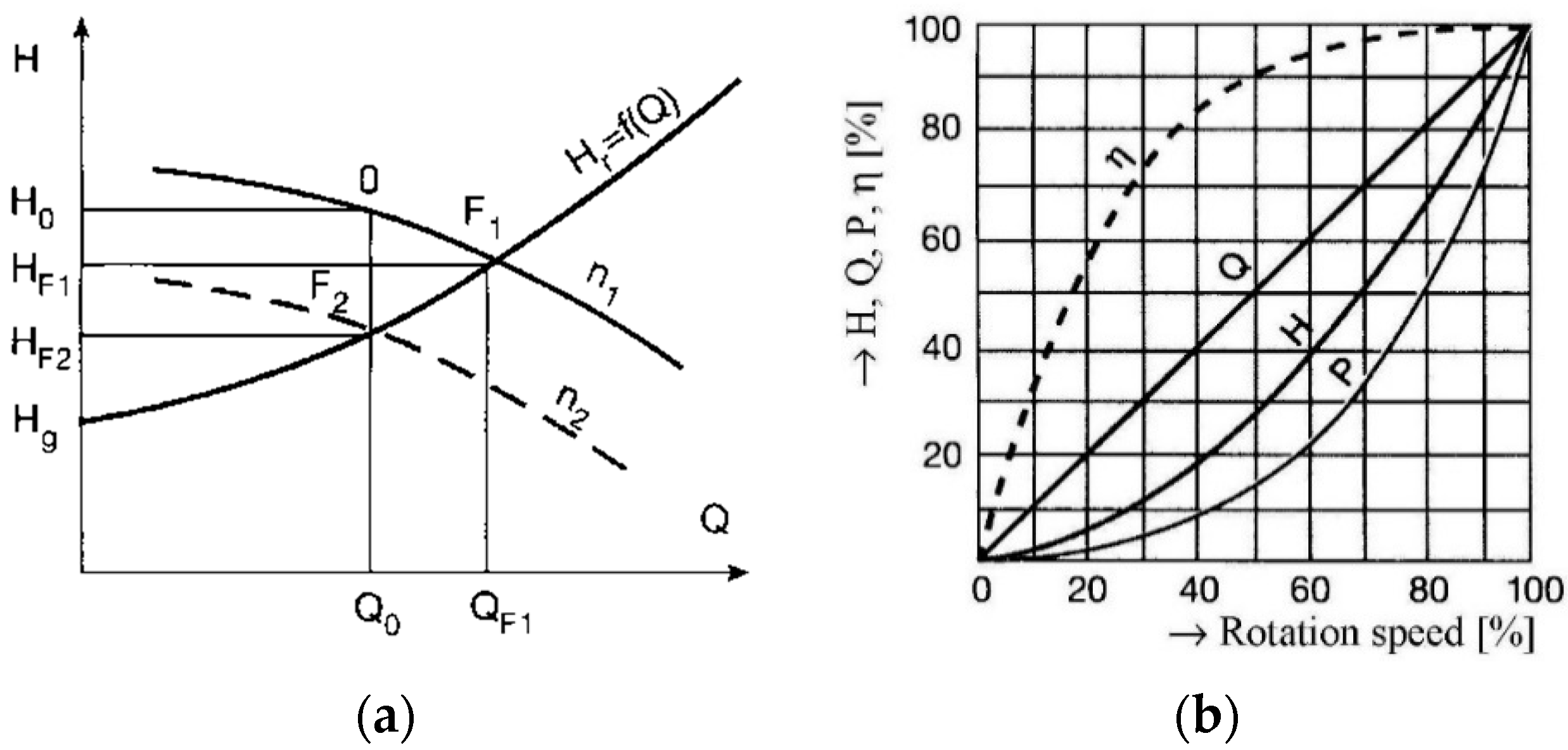

| Country | Served Citizens (%) | Pipe Length (km) | Heated Surface (106 m2) | Heating Capacity (MW) | Cooling Capacity (MW) |
|---|---|---|---|---|---|
| Denmark | 61 | 30,288 | n.a. | ||
| Sweden | 42 | 21,100 | 678 | 15,000 | 650 |
| Romania | 24 | 8973 | 500 | 9962 | |
| Austria | 21 | 4376 | 57 | 9500 | 35 |
| Germany | 12 | 20,151 | 438 | 49,931 | 161 |
| France | 7 | 3644 | n.a | 16,293 | 668 |
| Poland | 5 | 19,286 | 472 | 59,700 | |
| Italy | 5 | 2951 | 96 | 2556 |
| DH Network Generation | DH Network Type | Supply Temperature (°C) | Limitation | Suitable Terminal Unit |
|---|---|---|---|---|
| 1GDH | Very high temperature | 160–210 | The necessity of using condensate collection and transport equipment | High-pressure tubular heater |
| 2GDH | High temperature | 100–125 | The necessity of using pressurised tanks that may be linked directly to the system | Tubular heating radiator |
| 3GDH | Medium temperature | 65–95 | Minimum temperature for DHW in the tank (65 °C) | Radiator |
| 4GDH | Low temperature | 50–60 | Minimum DHW comfort temperature (50 °C) | Radiant system (floor, wall, ceiling), radiator, fan coil |
| Ultra-low temperature | 35–45 | Minimum floor heating temperature (35 °C) | Radiant floor | |
| 5GDH | Ambient temperature | 0–30 | Minimum supply temperature of WSHP (0 °C) | Radiant system |
| Renewable Energy Source | Annual Energy Potential | Energy Equivalent (ktoe) | Application |
|---|---|---|---|
Solar energy:
| 60 × 106 GJ | 1433.0 | Thermal energy |
| 1200 GWh | 103.2 | Electrical energy |
| Geothermal energy | 7 × 106 GJ | 167.0 | Thermal energy |
| Biomass | 318 × 106 GJ | 7594.0 | Thermal energy |
| Hydro-energy | 40,000 GWh | 3440.0 | Electricity |
| Wind energy | 23,000 GWh | 1978.0 | Electricity |
| Authors | Year | Research Subject | Outcomes |
|---|---|---|---|
| Weiss [53] | 2003 | Academic publication | Fundamentals of the system |
| Andersen et al. [54] | 2004 | SCS thermal performance in various climates | The thermal performance of an SCS is mainly determined by the energy balance |
| Kacan and Ulgen [55] | 2012 | Monthly energy savings are between 59 and 89%. The annual solar fraction (f) value is approx. 83% | |
| Asaee et al. [56] | 2014 | Different areas in Canada have f values ranging between 32% and 93% | |
| Ellehauge and Shah [57] | 2000 | Different system designs in the market | 33 to 50% is used for DHW, and the most typical system layout is two closed flow cycles for space heating and DHW |
| Kacan [58] | 2011 | Doctoral Thesis | f fraction values range from 10 to 100% |
| Hin and Zmeureanu [59] | 2014 | System optimisation | The payback periods (5.8 to 6.6 years) for various system configurations are unacceptable. |
| Geothermal Technology | Temperature of Wellhead Fluids | DHC Generation | Equipment to Feed Buildings | ||
|---|---|---|---|---|---|
| Space Heating | DHW | Cooling | |||
| Shallow | <25 °C | 5GDHC (ambient temperature) | HP | HP | EC/direct |
| Medium deep | 25–90 °C | 4GDHC (low temperature | HP/HX/direct | HP/HX/direct | AC |
| Deep | >90 °C | 2GDH and 3GDH (high and medium temperature) | HX/direct | HX/direct | AC |
| Performance | WSHP1 | WSHP2 | WSHP3 |
|---|---|---|---|
| SPF (–) | 5.33 | 5.37 | 5.37 |
| Thermal energy to the TES (MWh/year) | 1731 | 2054 | 2054 |
| Electricity consumption (kWh/year) | 324,748 | 382,432 | 382,432 |
| DHS | Et (MWh/year) | (MWh/year) | (t/year) | Eel,p MWh/year | SPFsys (%) |
|---|---|---|---|---|---|
| Existent | 5981 | 420 | 1542 | 0 | 0.89 |
| Modernised | 1446 | 39 | 347 | 1160 | 2.30 |
| Power Domain (kW) | <1.0 | 1.0–2.0 | 2.0–5.0 | 5.0–10.0 | >10.0 |
|---|---|---|---|---|---|
| Number of nodes | 17 | 25 | 39 | 17 | 14 |
| Total recovered power P (kW) | 7 | 36 | 122 | 117 | 209 |
| No. | Regulation Technique | Time τ (h) | Flow Rate Q (m3/h) | Pump Head H (m) | Power P (kW) | Electricity Eel (kWh/Day) | Specific Energy wp (kWh/m3) |
|---|---|---|---|---|---|---|---|
| 1 | Control valve | 6 | 2010 | 5.0 | 321.6 | 8531.2 | 0.167 |
| 4 | 1950 | 5.0 | 312.0 | ||||
| 4 | 2200 | 5.5 | 387.2 | ||||
| 4 | 2150 | 5.0 | 344.0 | ||||
| 6 | 2300 | 5.5 | 404.8 | ||||
| 2 | Speed control | 6 | 2010 | 4.6 | 183.6 | 5284.0 | 0.104 |
| 4 | 1950 | 4.6 | 167.6 | ||||
| 4 | 2200 | 5.2 | 240.7 | ||||
| 4 | 2150 | 4.6 | 224.7 | ||||
| 6 | 2300 | 5.3 | 275.1 | ||||
| Energy efficiency, ΔEel | (MWh/year) | 1185.2 | |||||
| (%) | 38.1 | ||||||
Publisher’s Note: MDPI stays neutral with regard to jurisdictional claims in published maps and institutional affiliations. |
© 2022 by the authors. Licensee MDPI, Basel, Switzerland. This article is an open access article distributed under the terms and conditions of the Creative Commons Attribution (CC BY) license (https://creativecommons.org/licenses/by/4.0/).
Share and Cite
Sarbu, I.; Mirza, M.; Muntean, D. Integration of Renewable Energy Sources into Low-Temperature District Heating Systems: A Review. Energies 2022, 15, 6523. https://doi.org/10.3390/en15186523
Sarbu I, Mirza M, Muntean D. Integration of Renewable Energy Sources into Low-Temperature District Heating Systems: A Review. Energies. 2022; 15(18):6523. https://doi.org/10.3390/en15186523
Chicago/Turabian StyleSarbu, Ioan, Matei Mirza, and Daniel Muntean. 2022. "Integration of Renewable Energy Sources into Low-Temperature District Heating Systems: A Review" Energies 15, no. 18: 6523. https://doi.org/10.3390/en15186523
APA StyleSarbu, I., Mirza, M., & Muntean, D. (2022). Integration of Renewable Energy Sources into Low-Temperature District Heating Systems: A Review. Energies, 15(18), 6523. https://doi.org/10.3390/en15186523








